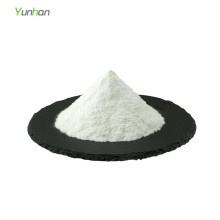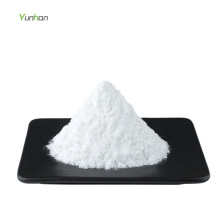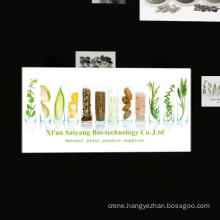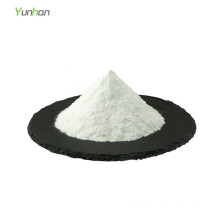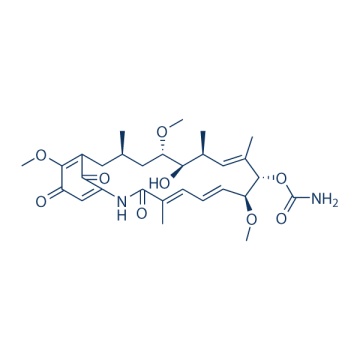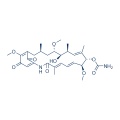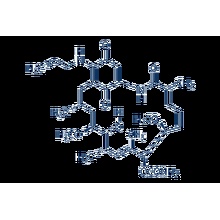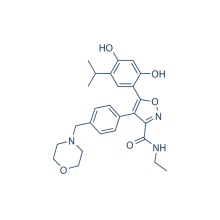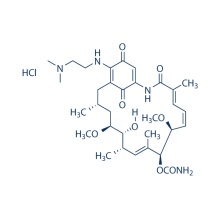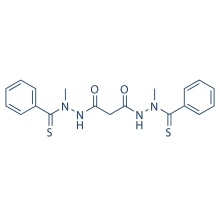Geldanamycin 30562-34-6
Product Description
Molecular Weight:
560.64 Geldanamycin is a natural existing HSP90 inhibitor with Kd of 1.2 μM, specifically disrupts glucocorticoid receptor (GR)/HSP association.
Biological Activity
Geldanamycin binds in the ATP-binding site in the N-terminus domain of
Hsp90s (residues 1-220). Geldanamycin inhibits the ATPase activity of
Hsp90 in a dose-dependent manner. Geldanamycin causes a dose-dependent
G2 arrest and reversible inhibiton o f entry into the S phase in A2780
human ovarian cell line. This inhibition is accompanied by p53 increase
and finally demonstrated to be p53 dependent. Geldanamycin causes
polyubiquitination and proteasomal degradation of the p185 receptor
protein-tyrosin kinase and shows a IC50 with 70 nM. Geldanamycin is a typical anti-tumor reagent, shows a mean GI50 with 0.18 μM against the panel of 60 human tumor cell lines.
Geldanamycin (50 mg//kg) shows 30% inhibition on pl85-associated phosphotyrosine levels in FRE/erbB-2 mice.
Protocol(Only for Reference)
Kinase Assay:
[1]
| Isothermal Titration Calorimetry (ITC) of Nucelotide Binding | The titration experiments are performed using the MSC system. In each experiment, 16 aliquots of 15 μL of geldanamycin (300 μM in 1% DMSO) are injected into 1.3 mL of protein (31 μM in 20 mMTris-HCl, pH 7.5, 1 mMEDTA) at 25 °C, and the resulting data are fit after subtracting the heats of dilution. Heats of dilution are determined in separate experiments from addition of geldanamycin into buffer and buffer into protein. No evidence for binding of DMSO in the nucleotide binding site is observed. Titration data are fit using a nonlinear least-squares curve-fitting algorithm with three floating variables: stoichiometry, binding constant (Kb) 1/Kd), and change of enthalpy of interaction (ΔH°). Dissociation constants estimated for geldanamycin binding to intact yeast Hsp90 is 1.22 μM, and for binding to Hsp90 N-terminal domain is 0.78 μM. No meaningful heat is observed with binding to the C-terminal fragment. |
|---|---|
| ATPase Assay | The ATPase assay is based on a regenerating coupled enzyme assay in which the phosphorylation of ADP by pyruvate kinase at the expense of phosphoenolpyruvate is coupled to the reduction of the resulting pyruvate by lactate dehydrogenase at the expense of |
Cell Assay:
[2]
| Cell lines | A2780 human ovarian cell line |
|---|---|
| Concentrations | 0.001-10 μM |
| Incubation Time | 3 hours |
| Method | Exponentially growing cells are treated with Geldanamycin and at various times DNA synthesis is assessed by incorporation of bromodeoxyuridine (BrdUrd) and flow cytometric analysis. No marked difference in total cell number is noted during this time course for treated and untreated cultures. BrdUrd (10 μM) is incorporated over a 4-h incubation period at 37 °C and cells are harvested and fixed in 70% ethanol. After denaturation of the DNA with 2 N HC1, cells are incubated with an anti-BrdUrd mouse monoclonal antibody followed by a fluorescein isothiocyanate (FITC)-linked goat anti-mouse IgG. Cells are stained for 30 minutes at room temperature with propidium iodide and analysed by flow cytometry using a Coulter EPICS Profile Analyzer. |
Animal Study:
[6]
| Animal Models | FRE/erbB-2 tumors in nu/nu mice |
|---|---|
| Formulation | Geldanamycin is dissolved in DMSO. |
| Dosages | 50 mg/kg |
| Administration | Administered via i.p. |
Conversion of different model animals based on BSA (Value based on data from FDA Draft Guidelines)
| Species | Baboon | Dog | Monkey | Rabbit | Guinea pig | Rat | Hamster | Mouse |
| Weight (kg) | 12 | 10 | 3 | 1.8 | 0.4 | 0.15 | 0.08 | 0.02 |
| Body Surface Area (m2) | 0.6 | 0.5 | 0.24 | 0.15 | 0.05 | 0.025 | 0.02 | 0.007 |
| Km factor | 20 | 20 | 12 | 12 | 8 | 6 | 5 | 3 |
| Animal A (mg/kg) = Animal B (mg/kg) multiplied by | Animal B Km |
| Animal A Km |
For example, to modify the dose of resveratrol used for a mouse (22.4 mg/kg) to a dose based on the BSA for a rat, multiply 22.4 mg/kg by the Km factor for a mouse and then divide by the Km factor for a rat. This calculation results in a rat equivalent dose for resveratrol of 11.2 mg/kg.
| Rat dose (mg/kg) = mouse dose (22.4 mg/kg) × | mouse Km(3) | = 11.2 mg/kg |
| rat Km(6) |
Chemical Information
| Molecular Weight (MW) | 560.64 |
|---|---|
| Formula | C29H40N2O9 |
| CAS No. | 30562-34-6 |
| Storage | 3 years -20℃Powder |
|---|---|
| 6 months-80℃in solvent (DMSO, water, etc.) | |
| Synonyms | NSC 122750 |
| Solubility (25°C) * | In vitro | DMSO | 100 mg/mL heating (178.36 mM) |
|---|---|---|---|
| Water | <1 mg/mL ( | ||
| Ethanol | <1 mg/mL ( | ||
| * <1 mg/ml means slightly soluble or insoluble. * Please note that Selleck tests the solubility of all compounds in-house, and the actual solubility may differ slightly from published values. This is normal and is due to slight batch-to-batch variations. | |||
| Chemical Name | 2-Azabicyclo[16.3.1]docosa-4,6,10,18,21-pentaene-3,20,22-trione, 9,13-dihydroxy-8,14,19-trimethoxy-4,10,12,16-tetramethyl-, 9-carbamate |
|---|
Molarity Calculator
Dilution Calculator
Molecular Weight Calculator
Contact us if you need more details on 30562-34-6. We are ready to answer your questions on packaging, logistics, certification or any other aspects about Geldanamycin 30562-34-6、30562-34-6 Geldanamycin. If these products fail to match your need, please contact us and we would like to provide relevant information.
Product Categories : Cytoskeletal Signaling > HSP Inhibitor
